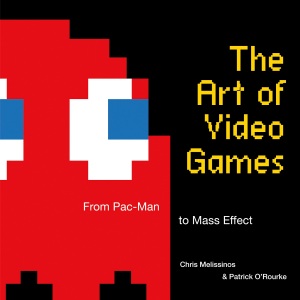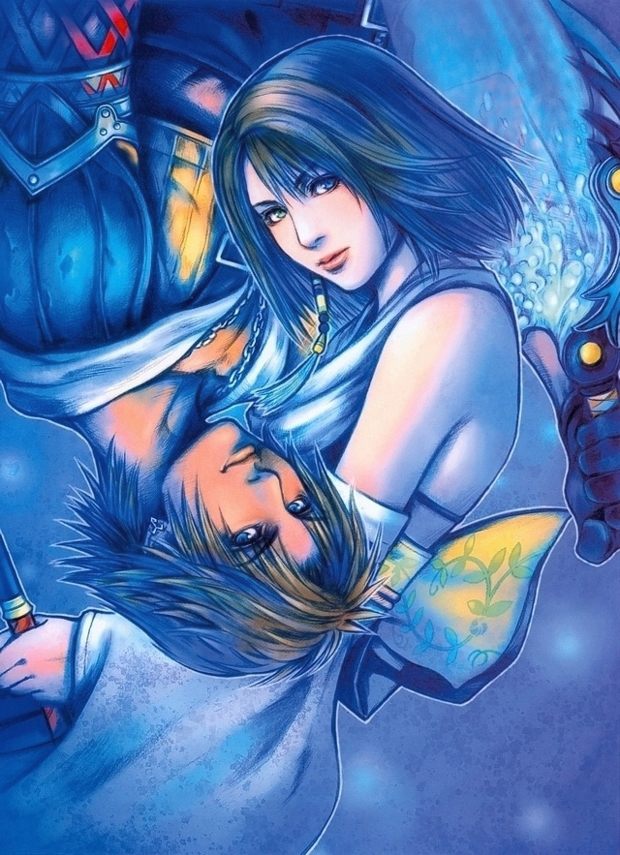Title: The Art of Video Games from Pac-Man to Mass Effect
Authors: Chris Melissinos and Patrick O’Rourke
Year Published: 2012
Publisher: Welcome Books
Pages: 215
I am going to be critical of this book.
I actually really like The Art of Video Games; and, even though I wasn’t able to attend the exhibition, I think the curators who organized it are superheroes. There need to be more books and more exhibitions like this. Plenty of people have written about how fantastic the book is, and I especially enjoyed Becky Chambers’s review on The Mary Sue. Since she did such a great job of explaining what the book is and why it is great, I’m going to focus on the structure and organization of the book and why I think these elements are flawed.
In short, I don’t think the video games featured in this book should be collectively considered as canonical or representative of the entirety of the beauty and artistry of video games.
It is my personal opinion (and I am willing to be corrected if I am wrong) that there is a huge gap between the video-game-related knowledge of people who play video games and the video-game-related knowledge of people who don’t play video games. People who play video games will generally have spent hundreds (if not thousands) of hours engaging with video games, reading about video games, and discussing video games with other gamers in person and online. They will generally be fairly well informed about their areas of video game expertise and have strong opinions about the games they have played. Even gamers who don’t have the skill set to play certain games are assisted by online walkthroughs and “Let’s Play” videos on Youtube, and most gamers generally read or watch reviews of more games than they have actually played. This applies not only to “hardcore” gamers, but also to “casual” gamers who spend an hour or two every week fooling around with games on their tablets or smartphones. To gamers, people like Katie Couric and Lauren Simonetti, who make broad generalizations about video games without ever having played them, are being highly intellectually irresponsible – it’s like saying Shakespeare is all about killing and violence without having read more than the top paragraph of the Wikipedia page on Macbeth.
To non-gamers who want to know more about video games, a book like The Art of Video Games may seem like a great source of information and a reliable guide. Make no mistake, this beautifully published book, which features dozens of titles and developer interviews, is a great place to start, and the institutional weight of the Smithsonian lends an undeniable air of credibility to the endeavor. Nevertheless, this catalog is far from complete, and it reflects the biases of the exhibition’s curators.
What I would like to argue is that, although the selection of titles featured in The Art of Video Games is obviously not random, the video games featured in the book don’t collectively form any sort of artistic canon and should not be treated as such.
To begin with, the organization and selection criteria of the games considered for inclusion have resulted in several peculiar idiosyncrasies. The book is organized in two ways: first, by gaming generation and console; and second, by four arbitrarily demarcated genres of video games (target, adventure, action, and tactics). What this means is that video game consoles with relatively limited libraries (such as the Sega Dreamcast) are given equal representation with video game consoles with enormous libraries (such as the Sony PlayStation). Also, even though the four genres are so nebulous as to be almost completely meaningless, the curators did their best to ensure equal representation between genres. What this means is that successful and popular games will be excluded in order to include niche games that fit neatly into one of the four genres.
In order to get an idea of how this organization limits the games that appear in The Art of Video Games, consider the book’s section on the Super Nintendo and the Sega Genesis. The Super Nintendo sold 49 million units, while the Sega Genesis sold 29 million units across its eight different releases. Although the two systems had comparable libraries in terms of number of available titles, the Super Nintendo had far more bestsellers in terms of millions of units worldwide than the Genesis. (I am not making these numbers up, by the way.) Still, in The Art of Video Games, both the Super Nintendo and the Sega Genesis are represented by four games each.
The single most iconic game of the Sega Genesis is Sonic the Hedgehog, which almost single-handedly rescued the Genesis from complete obscurity. Because there can only be one “action” game included, however, Sonic the Hedgehog is missing from the catalog, as it has been supplanted in the action category by Gunstar Heroes, which is just as excellent a game as Sonic (and Sonic II) but far less well known or influential. The strict genre categories thus limit effective representation of the strengths of the system and the unique characteristics of its game library.
Meanwhile, on the Super Nintendo side of the 16-bit section, the games featured are Super Mario World, A Link to the Past, Star Fox, and… SimCity? In their introduction to the section, the curators directly refer to all of the glorious role-playing games that sprang up like mushrooms in the console’s library, but the game they selected to represent the glory of the golden age of the RPG is a port of a simulation game that was released for personal computers. The organization schemata simply do not allow for the type of flexibility that would allow for both A Link to the Past and one of the role-playing games for which the system is so well known.
In 2011, the curators launched a website with 240 preselected games, which were divided into the aforementioned four genre categories. The website placed an open call to the online public to vote on which games would be included in the exhibit. According to Chris Melissinos, the chief curator of the exhibit, more than four million votes were tallied, and thus the eighty games featured in the exhibition and the catalog were selected.
Although this information may make it seem as if the games were selected by popular vote, what people were allowed to vote on was in fact severely limited by the curator’s decisions. According to the criteria established by the curators, voters had to choose only one game from each genre, and there was no option to switch a certain game between genres or to suggest a game that wasn’t listed on the form. Such voting mechanics effectively established a rigid quota system, which shut out evergreen gaming mainstays such as the Final Fantasy franchise.
Another major limitation of the selection of games in The Art of Video Games is that it does not include games from handheld consoles. There is thus no Pokémon, which is the second most profitable video game franchise in the world (after Mario). None of the amazing work that Nintendo did with the phenomenally successful Nintendo DS system (as exhibited in games such as Phantom Hourglass and Bowser’s Inside Story) is mentioned, nor are the bestselling social games popular on the PlayStation Portable, such as the many titles of the Monster Hunter franchise. Smartphone and tablet games such as the groundbreaking Angry Birds series are also notably absent.
Another obvious limitation on the exhibition is took place in early 2012, which is already more than a year ago. Thus, the catalog includes BioShock but not BioShock Infinite, and Flower but not Journey.
Furthermore, there are no sports games, no fighting games, no lifestyle or party games (like Wii Fit or Guitar Hero), and no MMORPGs. It’s almost as if these sorts of games don’t fall into the category of “art” that the curators are trying to promote. On the other side of the spectrum, the catalog also excludes the more experimental and artsy games released for direct download on platforms like the Xbox Live Arcade, such as Limbo and Fez and Braid. Steam and its vast library of indie games are also not mentioned.
Finally, fan favorite games that never officially made it to the United States, such as Mother 3 and Terranigma, are completely ignored. Shūkan Famitsū magazine (probably the most respected video game periodical in Japan) ran a survey in 2006 polling Japanese gamers on their favorite games; and, to no one’s surprise, the list is dominated by Final Fantasy and Dragon Quest. No Dragon Quest titles appear in The Art of Video Games, however; and Final Fantasy X, which is at the top of the Famitsū list and extremely well received worldwide, is absent as well. The “visual novel” games that are popular in Japan (and popular abroad when they are imported and localized, such as in the case of 999: Nine Hours, Nine Persons, Nine Doors) are also ignored.
In fact, the entire project feels very centered on the United States. Of the fifteen creator interviews included in The Art of Video Games, none are with anyone working primarily in Japan or with a Japanese company. It’s almost as if Japanese people had nothing to do with video games at all. Of course the institution hosting the exhibition is the Smithsonian American Art Museum, but many (if not most) of the video games featured in the catalog are Japanese in origin, and Japanese industry professionals such as Kojima Hideo were invited to participate in the events surrounding the exhibition. The Art of Video Games therefore does a great job of demonstrating that Japanese video games are very popular with American gamers, but it doesn’t explain how or why this is.
As I wrote earlier, I admire and appreciate The Art of Video Games. It’s beautifully published, the gorgeous layout and page design make flipping through the book feel like an adventure, and the text is informative and concise.
Still, I hope I’ve given a convincing argument for why I think the collection of games featured in The Art of Video Games should not be considered canonical or representative of the relative merits of any single title included or not included. Moreover, the games represented are not necessarily the most innovative and influential video games to have ever been released. I believe that the inflexible organization and arbitrary genre-based selection criteria play an important role in what games made the cut for this exhibition and its catalog. As with any sort of “anthology” of this type, the selection of titles included has a great deal to do with the personal experiences and life histories of its compilers. I have to hand it to the curators: they did a fantastic job. My criticism of the book they’ve put together is not a result of any failure on their part, but rather indicative of the extraordinary development of video games as a medium of artistic expression.


